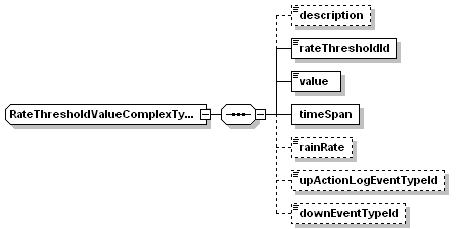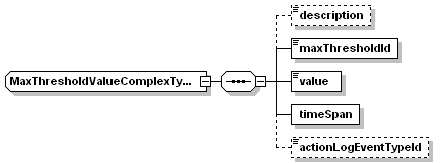What |
Required |
Description |
schema location |
|---|---|---|---|
ThresholdValueSets.xml |
no |
definition of threshold values for all locations and data types |
http://fews.wldelft.nl/schemas/version1.0/thresholdValueSets.xsd |
Complementary to the definition of the types of thresholds identified, the values of the thresholds are defined in the ThresholdValueSets configuration. The configuration of this is similar to the validation rules. Several thresholds may be defined per time series. For each time series to be tested, a set of thresholds is defined.
Thresholds may be defined to initiate an action by the Master Controller when applied in a live forecasting system. Actions are taken in response to a log event code. To identify which threshold crossing for which locations will initiate an actions (e.g. enhanced forecasting), an event code can be defined in the ThresholdValueSet. When the threshold is crossed the event code is generated.
When available on the file system, the name of the XML file for configuring the ThresholdValueSets is for example:
ThresholdValueSets 1.00 default.xml
ThresholdValueSets Fixed file name for the ThresholdValueSets configuration
1.00 Version number
default Flag to indicate the version is the default configuration (otherwise omitted).
Figure 39 Elements of the ThresholdValueSets configuration.
thresholdValueSet
Root element for defining a set of thresholds. For each time series or time series set for which a threshold event is to be tested new element is required.
Attributes;
- Id: Id of the thresholdValueSet defined.
- Name: optional name, for reference purposes only
description
Optional description for the ThresholdValueSet. Used for reference purposes only
levelThresholdValue
Definition of values for level thresholds.
rateThresholdValue
Definition of values for rate thresholds.
maxThreshold
Definition of values fro peak event thresholds.
timeSeriesSet
Definition of the time series set for which the thresholds are to be tested.
Defining level thresholds
Figure 40 Elements of the Level Threshold configuration of the ThresholdValueSets configuration
levelThresholdId
Id of the level threshold. This Id must refer to a threshold type defined in the Thresholds definition (see previous paragraph).
value
Value of the threshold.
upActionLogEventTypeId
Event code to be generated on the up-crossing of the threshold. This event code can be used to initiate for example enhanced forecasting. The event code need not be unique. Multiple threshold crossings may generate the same event code. Note that event codes will only be generated for runs which have an a-priori approved status. This is normally the scheduled forecast run.
downActionLogEventTypeId
Event code to be generated on the down-crossing of the threshold. This event code can be used to initiate for example enhanced forecasting. The event code need not be unique. Multiple threshold crossings may generate the same event code. Note that event codes will only be generated for runs which have an a-priori approved status. This is normally the scheduled forecast run.
Defining rate thresholds
Figure 41 Elements of the Rate Threshold configuration of the ThresholdValueSets configuration
rateThresholdId
Id of the rate threshold. This Id must refer to a threshold type defined in the Thresholds definition (see previous paragraph).
value
Value of the rate threshold that must be exceeded in timeSpan.
timeSpan
Time span to use to establish the rate.
rainRate
Boolean indicator to identify thresholds in rain rates where the threshold is defined as the average rainRate over the timeSpan exceeding the threshold, and a rate in for example a level where the rate is determined as the value divided by the time span.
upActionLogEventTypeId
Event code to be generated on the up-crossing of the threshold. This event code can be used to initiate for example enhanced forecasting. The event code need not be unique. Multiple threshold crossings may generate the same event code. Note that event codes will only be generated for runs which have an a-priori approved status. This is normally the scheduled forecast run.
downActionLogEventTypeId
Event code to be generated on the down-crossing of the threshold. This event code can be used to initiate for example enhanced forecasting. The event code need not be unique. Multiple threshold crossings may generate the same event code. Note that event codes will only be generated for runs which have an a-priori approved status. This is normally the scheduled forecast run.
Defining peak event thresholds
Figure 42 Elements of the maxThreshold configuration of the ThresholdValueSets configuration
maxThresholdId
Id of the max threshold. This Id must refer to a threshold type defined in the Thresholds definition (see previous paragraph).
value
The value item is used here as a selection of peaks. The peak must exceed this value to be deemed significant (peaks over threshold)..
timeSpan
The timeSpan is used to establish independence of peaks. Peaks within timeSpan of each other are considered as being of the same event as a message will only be issued for the highest.
actionLogEventTypeId
Event code to be generated on the threshold occurring. This event code can be used to initiate for example enhanced forecasting. The event code need not be unique. Multiple threshold crossings may generate the same event code. Note that event codes will only be generated for runs which have an a-prioriapproved status. This is normally the scheduled forecast run.



